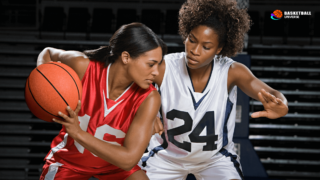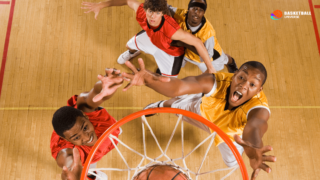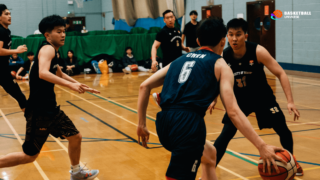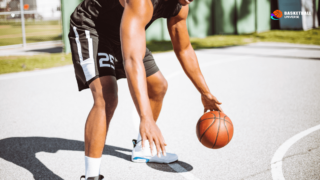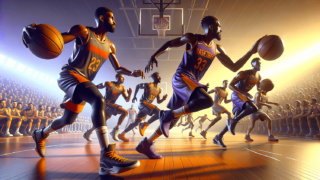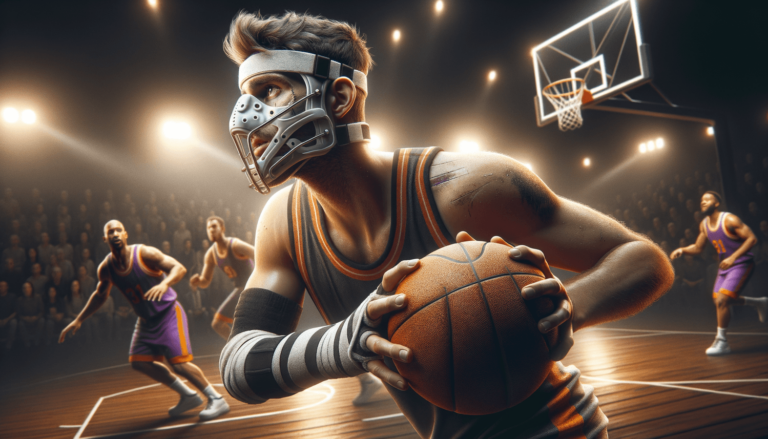
Ever found yourself in the midst of an extremely captivating basketball game, fired up to show off your dribbling skills, and suddenly, fate steps in and you wind up with a broken nose? Ouch! You might be wondering, “Is my hoop dream shattered, or can I still hit the court with this busted sniffer?” Fear not, as this blog post will delve into that very question: Can You Play Basketball with a Broken Nose? We’ll explore possible scenarios, necessary precautions, and provide you with nuggets of wisdom from both medical and sports professionals. So grab some ice for that swollen proboscis and let’s break it down together (the information, not your nose, of course).
Can You Play Basketball with a Broken Nose?
Yes, it is possible to play basketball with a broken nose, but it is highly dependent on the severity of the injury, pain tolerance, and the approval of a medical professional. A protective face mask is often recommended to prevent further injury, and taking necessary precautions is crucial to ensure a safe return to the court.
Understanding Your Injury: The Broken Nose
A broken nose, or a nasal fracture, typically occurs when there’s significant trauma to the nasal bones. Basketball, with its energetic and physical nature, presents many opportunities for accidents, such as taking an elbow to the face or an unfortunate collision with a teammate or opponent. But before you consider stepping back onto the court, it’s crucial to comprehend the nature and extent of your injury.
Symptoms of a Broken Nose
First, it is essential to spot the signs of a broken nose. These may include:
- Pain and tenderness around the nose
- Swelling in the nasal region
- Bruising or black eyes
- Bloody nose
- Difficulty breathing through the nostrils
- Deviated or crooked nose
If you experience any of these symptoms, it’s vital to seek medical attention to diagnose and assess the extent of your injury accurately.
So, You’ve Got a Broken Nose: What Now?
Once you’ve determined that you’ve indeed got a broken nose, it’s time to weigh the essential factors and precautions before attempting to play basketball again. Let’s explore these aspects in detail.
Severity of the Injury
Medical professionals will categorize your nasal fracture into one of three types:
- Type I: Minor fracture with little to no displacement
- Type II: Moderate fracture with some displacement of the nasal bones
- Type III: Severe fracture with significant displacement of the bones and possible involvement of other facial structures
Naturally, a Type I fracture may allow for an earlier return to the court compared to someone with a Type III fracture. Consulting with a doctor is critical for determining what type of fracture you have and the appropriate next steps based on the injury’s severity.
Get the Green Light from a Medical Professional
Never attempt to return to playing basketball without first getting the go-ahead from your doctor. They will assess your injury and guide you on the safest course of action, considering crucial factors such as healing progress and likelihood of re-injury. Always prioritize your health and follow your doctor’s recommendations.
Protective Gear: Your Road to Recovery and Hoop Dreams
One of the primary concerns when attempting to play basketball with a broken nose is the risk of further injury. The introduction of basketball protective gear, specifically face masks, has enabled athletes to return to their beloved sport more quickly and safely.
The Benefits of Wearing a Protective Face Mask
A protective face mask, designed to guard the nose and face from further impact, provides injured players with several key benefits:
- Protection: It shields the nose and other facial structures against re-injury and allows for safer play.
- Confidence: Wearing a mask helps instill a sense of security, enabling players to focus on their game rather than worrying about their injury.
- Comfort: Modern face masks are lightweight and comfortable to wear, without hindering performance on the court.
Purchasing a well-fitting, high-quality face mask is a must if you plan to play basketball with a broken nose.
Practical Tips: Preparing Yourself for a Safe Return
Armed with a protective face mask and your doctor’s approval, you’re getting closer to stepping back onto the court. However, some practical tips will help ensure a smoother and safer transition back to playing basketball with a broken nose.
Tip #1: Gradually Increase the Intensity
As eager as you may be to jump back into the action, it’s crucial first to ease yourself into the game slowly. Start with individual drills and basic exercises to regain your strength and confidence on the court. Gradually increase practice intensity and incorporate scrimmages to simulate real-game scenarios.
Tip #2: Monitor Your Pain Tolerance
Listen to your body and be mindful of how you feel when engaging in basketball activities. Even with a protective mask, you may still experience discomfort, especially when wearing the mask for extended periods. Don’t push yourself beyond your pain tolerance, and remember to communicate with your doctor and coach about your pain levels during practice.
Tip #3: Alter Your Playing Style
Returning to basketball with a broken nose means you may need to modify your playing style temporarily. For instance, consider playing a less aggressive role and focusing more on shooting, passing, and playmaking. This change can reduce your risk of re-injury while still contributing to your team’s success.
Tip #4: Keep Up the Communication
Keep your teammates and coach informed about your injury and how you’re feeling. Their support and understanding go a long way in ensuring your safety on the court. Additionally, your teammates will be better prepared to protect you and adjust their gameplay to accommodate your needs during this recovery period.
Notable NBA Players with Broken Noses: Lessons to Learn
The history of basketball is replete with players who have experienced broken noses and have valiantly returned to the court. Let’s examine some notable cases, and glean valuable lessons from their experiences.
Kobe Bryant
The late Lakers legend Kobe Bryant suffered a broken nose during the 2012 NBA All-Star Game. Despite his injury, Kobe returned to the court wearing a protective mask and continued to display his trademark skill and determination. The lesson? Guarding yourself with a protective mask and maintaining a fighting spirit can lead to a successful return to the game.
LeBron James
During the 2014 NBA season, LeBron James broke his nose in a game against the Oklahoma City Thunder. He returned to the court wearing a black protective mask, scoring an impressive 31 points in his first game back. The takeaway? Focus on your skillset and adjust your playing style if needed to find continued success, despite your injury.
Russell Westbrook
Oklahoma City Thunder’s point guard Russell Westbrook encountered a broken nose in a 2015 game. He returned to the court wearing a clear protective mask, and within weeks, had a string of triple-doubles. The lesson? Obtain as much practice as possible with your protective mask on to get acclimated to the new gear and enhance your performance.
In conclusion, playing basketball with a broken nose is feasible, yet it’s essential to address the injury’s severity, seek medical clearance, wear a protective face mask, and take necessary precautions. The insight and experiences of successful NBA players can inspire and inform your return to the court.
Recovery and Self-Care: Getting Back on Track
While gearing up to rejoin your team on the court, it’s crucial not to overlook the importance of adequate recovery and self-care for your broken nose. In this section, we’ll delve into essential practices and advice to get you back in the game, both physically and mentally.
Nasal Care during Recovery
Proper nasal care during recovery plays a significant role in reducing the risk of complications, such as infections or longer healing times. Adhere to the following recommendations to ensure a better and safer healing process:
- Keep your nasal area clean and dry. After consultations with your doctor, clean the area gently with mild soap and water.
- Avoid blowing your nose, which might cause increased pressure or pain.
- Keep your head elevated when sleeping or lying down to reduce swelling.
- Manage your pain with prescribed or over-the-counter medication, as directed by your doctor.
- Limit physical activities that might exacerbate the injury or lead to further accidents.
Mental Resilience: Overcoming the Fear of Re-Injury
Bouncing back from a broken nose involves not only physical healing but also the ability to overcome the fear of re-injury. Adopting a positive mindset and mental resilience is paramount to ensuring a fully-rounded recovery. Here are some tips to help you regain your confidence:
- Engage in meditation, visualization, or deep breathing exercises to stay calm and focused.
- Set progressive, achievable goals, both short-term and long-term, to track your recovery progress and boost your motivation.
- Remind yourself of your love for basketball and visualize yourself thriving on the court once again.
- Stay committed to a training routine and gradually expose yourself to situations you might initially find uncomfortable (within your doctor’s recommendations).
- Don’t be afraid to express your concerns and emotions to your support system, including family, friends, teammates, coaches, or sports psychologists.
Preventing Future Basketball Nose Injuries
While accidents in basketball can be hard to predict and avoiding them is not always possible, there are strategies to help minimize the risk of future nose injuries. Implement the following preventative measures to stay safe on the court:
- Warm-up and stretch adequately before each practice session or game to improve flexibility, reduce muscle stiffness, and prevent collateral damage to bones and joints.
- Remain aware of your surroundings and maintain proper situational awareness during gameplay to avoid collisions or dangerous situations.
- Consider wearing a protective face mask as a precautionary measure, even after your nose has healed, especially if you’re prone to nasal injuries.
- Strengthen your balance and improve your agility through targeted exercises, which can promote better body control and overall injury prevention.
By adhering to the advice above, prioritizing self-care during recovery, and taking preventive measures, you’ll be well-prepared to return to playing basketball with a focus on safety and success.
Frequently Asked Questions: Broken Nose and Basketball
Given the nature of queries surrounding broken noses and basketball, we’ve compiled a list of frequently asked questions (FAQs) to address some common concerns, along with short, informative answers to set your mind at ease.
1. How do I know if I have a broken nose?
Signs of a broken nose may include pain, swelling, bruising, nosebleed, difficulty breathing through nostrils, and visible deviation. It’s essential to consult a medical professional for an accurate diagnosis and appropriate treatment.
2. Can I play basketball immediately after breaking my nose?
Returning to play immediately after breaking your nose is not advised, as it can worsen the injury and prolong the healing process. Consult with a healthcare professional before resuming basketball activities.
3. How long should I wait before playing basketball again?
The recovery time varies based on the injury’s severity and individual healing rates. Consult with your doctor, who can provide personalized guidance based on your unique situation.
4. How do I properly care for my broken nose during recovery?
Keep the affected area clean and dry, avoid blowing your nose, elevate your head when resting, and follow pain management instructions provided by your doctor.
5. Do I need to wear protective gear after breaking my nose?
A protective face mask is highly recommended when resuming basketball activities. It prevents further damage, instills confidence, and allows the player to focus on their game.
6. How do I regain my confidence after breaking my nose?
Gradually ease into basketball activities, maintain a positive mindset, set achievable goals, engage in visualization or meditation, and communicate with your support network.
7. Can a broken nose affect my basketball performance?
Initially, a broken nose may cause discomfort while playing; however, with an appropriate recovery plan and protective measures, most players can resume their pre-injury level of performance.
8. What are some essential preventive measures to avoid future nose injuries?
Always warm up and stretch before games, stay aware of your surroundings, wear a protective face mask, and work on improving balance and agility through targeted exercises.
9. How do the medical professionals categorize nasal fractures?
Doctors typically categorize nasal fractures as Type I (minor), Type II (moderate), and Type III (severe), depending on the level of bone displacement and involvement of other facial structures.
10. Can a broken nose cause breathing problems?
Yes, a broken nose can cause temporary breathing difficulties due to swelling, inflammation, or structural damage. Seek medical advice to address these issues appropriately.
11. How can I reduce swelling after breaking my nose?
Applying cold packs to the affected area, keeping your head elevated, and taking over-the-counter anti-inflammatory medications (as directed by your doctor) can help reduce swelling.
12. Can I exercise while recovering from a broken nose?
It’s advised to avoid strenuous activities that may exacerbate the injury or impede recovery. Consult with your doctor for guidelines on when and how to resume exercise.
13. Is a misaligned nose always a sign of a fracture?
Though a misaligned or deviated nose can be a symptom of a fracture, it’s not always indicative of one. Consult a healthcare professional to determine the nature and extent of your injury.
Featured Posts
- No pillar pages found.
